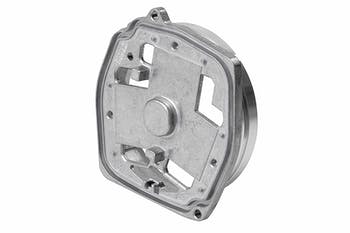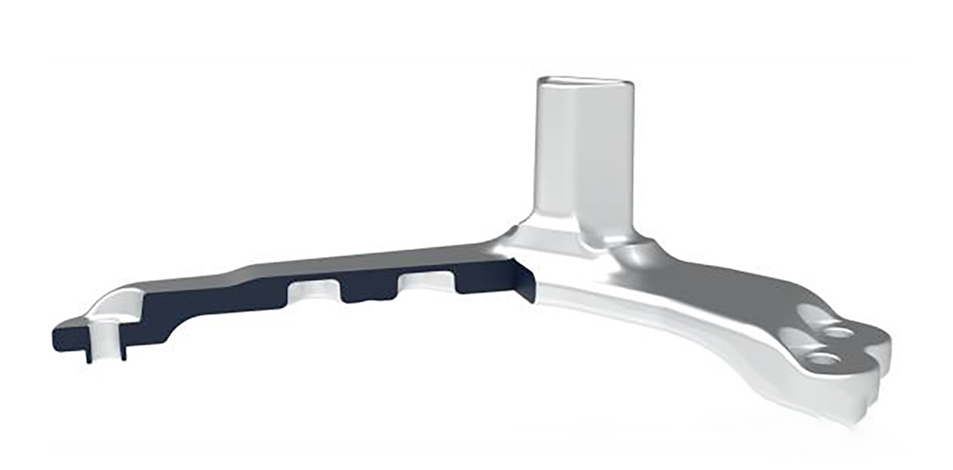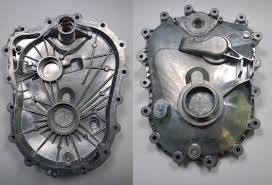
2024 European Aluminum Die Casting Award" Winning Aluminum Alloy Die Castings(Part1)
2024-01-22 04:53
During EUROGUSS 2024, the European (Nuremberg) Die Casting Industry Exhibition, the organizers conducted expert evaluations and selected the "2024 European Aluminum Die Casting Award."
Automotive Electronic Power Steering System Radiator

Description of the casting design, casting, and molding requirements, applicable to assembly components:
Components with extremely high tolerance requirements, and a high demand for no porosity/voids in the groves, which are machined to generate these porosities/voids. Due to the need for mass production, fully automated machining is required, including 100% End-of-Line (EOL) camera inspection of the voids in the grooves (evaluating quantity, size, and location).
Design, Casting, and Molding Requirements:
Casting Challenge: Manufacturing multiple molds on limited machine sizes. The requirement for minimal internal defects or defects of approximately 2 millimeters on machined surfaces is very high, necessitating the full utilization of all possibilities of the die-casting machine or processes related to the casting process.
Why Adopt Die Casting?
Achieve optimal heat dissipation using aluminum.
Technical Data:
Alloy: AlSi12
Length: 91 mm
Width: 92 mm
Height: 21 mm
Weight: 114 grams
Bracket

Description of the casting design, casting, and molding requirements and their functions, including assembly components:
Chassis components are produced by die-casting. No machining. T6 heat treatment.
Design, Casting, and Molding Requirements:
Substitute for forged parts with the same mechanical characteristics and reduced weight.
Why Produce by Die Casting?
Cost savings, cast to final contour, no additional machining.
Why This Part Won the European Die Casting Award?
Innovative and unique possibilities for cost savings and weight reduction.
Technical Data:
Alloy: AlSi7Mg
Length: 325 mm
Width: 180 mm
Height: 100 mm
Weight: 886 grams
Transmission Cover InDrutec-E

Description of the casting design, casting, and molding requirements and their functions, including assembly components:Innovative aluminum transmission cover for electronic shaft devices (system casing), significantly improved compared to the reference components of a similar series.
Design, Casting, and Molding Requirements:Cast with Vacural® casting process for high-strength aluminum alloy. The weight of the aluminum component, optimized topologically, is reduced by 38% compared to the reference components.
These improvements are the result of in-depth research and innovative design aimed at maximizing lightweight potential while achieving environmental and economic benefits.
38% lighter, 30% cheaper;
30% cheaper, 60% reduction in carbon dioxide emissions;
60% reduction in carbon dioxide emissions.
Why Adopt Die Casting Production?
The weight advantage is primarily achieved through an innovative structural method characterized by direct load flow and three-dimensional reinforcement on heavy-duty closed surfaces. Forces and loads are evenly distributed over the entire structure's tensile surface, avoiding noticeable stress peaks. This means that the material used is better utilized. Additionally, the use of advanced high-strength AlMgSi alloy in structural castings further reduces weight. As a result, the weight is reduced from 2.50 kg to 1.55 kg, and the fatigue strength and operational reliability of the entire system are improved. This is particularly evident in the design, where minimal reinforcing ribs are needed on the outer surface. The reduction in contact surfaces and storage pockets also lowers corrosion susceptibility.
On the other hand, the adoption of a naturally corrosion-resistant alloy (requiring no heat treatment), with 95% recyclable components, eliminates the need for rare earth or gas treatment, reducing cost-driving factors. Using Vacural® casting technology reduces waste rates, thus lowering costs. Moreover, in designing the component, care is taken to ensure that the mold does not require sliding, further reducing complexity and costs. However, the cost of the AlMgSi alloy and Vacural® casting process is slightly higher compared to the reference material (AlSi10MgMn; vacuum-assisted). Nevertheless, overall cost savings are over 30%.
Sustainability can be quantified through carbon dioxide balance savings. Weight reduction (and thus reduced material demand), the use of highly recyclable alloy, elimination of heat treatment, and reduced waste rates all contribute positively, resulting in at least a 60% reduction in carbon dioxide emissions.
In conclusion, the innovative transmission cover provides a comprehensive range of improvements, significantly enhancing the performance, reliability, and efficiency of the electronic shaft device at a significantly lower cost. Simultaneously, it contributes to sustainability by reducing weight and considering ecological factors. This innovation marks a step forward in the further development of cast components for future automotive drive systems.
The decision to use die casting to manufacture this component is based on considerations in the following technical, economic, and ecological aspects:
Precise and efficient utilization of materials with complex geometries without expensive post-processing steps.
Functional integration, such as bearing seats, screw fixation points, air outlets, oil inlets, and outlets, while minimizing additional processing steps.
The use of aluminum alloy with a recycling rate of up to 95%, effectively reducing carbon dioxide emissions and lowering costs.
Achieving the lowest possible porosity through the Vacural® casting process, improving material performance and reducing waste.
Why This Part Won the European Die Casting Award?
1. Innovative Application Solution:
The use of secondary alloys in three-dimensional reinforcement components resulted in a 38% weight reduction compared to aluminum reference materials.
2. Die Casting-Compatible, Resource-Efficient Design:
The new design method concentrates material in the tensile load area consistent with the load flow, reducing bending moments and stress peaks. This ensures even loading, maximizing material efficiency, and saving over 30% of costs.
3. Complexity and Quality Characteristics:
This design significantly reduces complexity and almost eliminates the need for reinforcing ribs on the external surface, greatly enhancing corrosion resistance. Unlike the reference, this component doesn't require any sliders, avoiding detrimental material accumulations.
4. Sustainable Alloy Selection:
The use of secondary alloy with a recycling content of 95%, eliminating the need for additional heat treatment, rare earth, and gas treatment, resulting in at least a 60% reduction in carbon dioxide emissions.
5. Efficient Manufacturing Method:
Vakural® casting technology reduces porosity and waste, enhancing the performance of the material used.
Technical Data:
Length: 340 mm
Width: 260 mm
Height: 100 mm
Weight: 1550 grams
Get the latest price? We will reply as soon as possible (within 12 hours)
